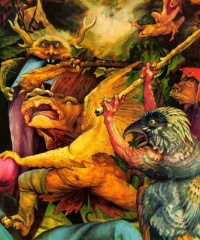Pretexts for violence in art
From The Art and Popular Culture Encyclopedia
| Revision as of 21:11, 14 June 2009 Jahsonic (Talk | contribs) ← Previous diff |
Revision as of 22:32, 19 October 2009 Jahsonic (Talk | contribs) (→The Temptation of Saint Anthony) Next diff → |
||
| Line 8: | Line 8: | ||
| Over time, secular excuses for showing the undraped human form complemented and, later, supplanted these historical, mythological, and religious pretexts, athleticism being one such excuse, as in [[Edouard Manet]]’s ''[[Olympia (painting)|Olympia]]''. In the traditional arts, [[nudity]] has long since become accepted, but the same is not yet true with regard to more recent artistic [[media]], such as [[film]]. | Over time, secular excuses for showing the undraped human form complemented and, later, supplanted these historical, mythological, and religious pretexts, athleticism being one such excuse, as in [[Edouard Manet]]’s ''[[Olympia (painting)|Olympia]]''. In the traditional arts, [[nudity]] has long since become accepted, but the same is not yet true with regard to more recent artistic [[media]], such as [[film]]. | ||
| + | |||
| + | ==== Martyrology ==== | ||
| + | :''[[San Sebastian]], [[Saint Agatha]], [[martyrology]]'' | ||
| ==== The Temptation of Saint Anthony ==== | ==== The Temptation of Saint Anthony ==== | ||
Revision as of 22:32, 19 October 2009
|
Related e |
|
Featured: |
- pretexts for nudity in art, aestheticization of violence, graphic violence, death in art, art horror
Before the 1850s and the birth of modern art, artists needed an excuse to depict violence and sexuality in their paintings or engravings. Mythology and martyrology provided an excuse to display these themes.
Contents |
Overview
Due to censorship, artists past and present, have to resort to pretexts for displaying the naked human form. With painters of the past, the depiction of historical, mythological, and religious subjects often provided such pretexts for nudity in art, as in the temptation of saint Anthony (Félicien Rops and Hieronymus Bosch, more recently, Salvador Dalí), the massacre of the innocents, the battle of the Lapiths and the centaurs), Leda and the Swan, the three graces, and Venus, who has become a byword for the female nude, tout court.
Over time, secular excuses for showing the undraped human form complemented and, later, supplanted these historical, mythological, and religious pretexts, athleticism being one such excuse, as in Edouard Manet’s Olympia. In the traditional arts, nudity has long since become accepted, but the same is not yet true with regard to more recent artistic media, such as film.
Martyrology
The Temptation of Saint Anthony
Some of the stories included in Saint Anthony's biography are perpetuated now mostly in paintings, where they give an excuse for artists to depict their more lurid or bizarre fantasies. Many pictorial artists, from Félicien Rops and Hieronymus Bosch to Salvador Dalí, have depicted these incidents from the life of Anthony; in prose, the tale was retold and embellished by Gustave Flaubert.
Massacre of the Innocents
The theme of the "Massacre of the Innocents" has provided artists with opportunities to compose complicated depictions of massed bodies in violent action. Artists of the Renaissance took inspiration for their "Massacres" from Roman reliefs of the battle of the Lapiths and Centaurs to the extent that they showed the figures heroically nude. Guido Reni's early (1611) Massacre of the Innocents, in an unusual vertical format, is at Bologna. Peter Paul Rubens painted the theme more than once.
The Last Judgment
In art, the Last Judgment is a common theme in medieval and renaissance religious iconography. Like most early iconographic innovations, its origins stem from Byzantium. In Western Christianity, it is often the subject depicted on the central tympanum of medieval cathedrals and churches, or as the central section of a triptych, flanked by depictions of heaven and hell to the left and right, respectively (heaven being to the viewer's left, but to the Christ figure's right). The most famous Renaissance depiction is Michelangelo Buonarroti's in the Sistine Chapel. Included in this is his self portrait, as St. Bartholomew's flayed skin.
Judith
The subject: a daring and beautiful woman Judith in her full maturity, dressed as for the feast with all her spectacular jewels, accompanied by an apprehensive maid, succeeds in decapitating the invading general, Holofernes. The moral is as much about the dangers of a beautiful woman, as had been told of Delilah and Samson, but here the woman was a culture-hero to the listeners.
Medusa
Caravaggio's and Rubens's Medusa.
Salome
The Biblical story of Salome has long been a favourite of painters, since it offers a chance to depict oriental splendour, semi-nude women, and exotic scenery under the guise of a Biblical subject. Painters who have done notable representations of Salome include Titian and Gustave Moreau.
The Rape of the Sabine Women
The Rape of the Sabine Women ("rape" in this context meaning "kidnapping" rather than its modern meaning) is an episode in the legendary early history of Rome narrated by Livy and Plutarch ('Lives' II, 15 and 19). It provided a subject for Renaissance and post-Renaissance works of art that combined a suitably inspiring example of the hardihood and courage of ancient Romans with the opportunity to depict multiple figures in intensely passionate struggle.


